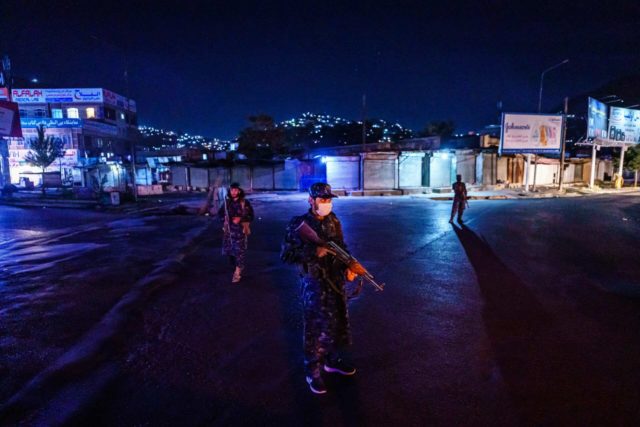
Taliban says new troops near central Asian borders will bring stability. The neighbors are not so sure. Taliban fighters in their new uniforms station themselves at a large traffic junction for a nightly security checkpoint, in Kabul, Afghanistan, Sunday, September 5, 2021. (Marcus Yam/Los Angeles Times/TNS)
This article was originally published by Radio Free Europe/Radio Liberty and is reprinted with permission.
Afghanistan’s Taliban-led Defense Ministry has established several new military units in three border provinces in the country’s north, northeast, and west, deploying an estimated 4,400 additional troops in the region.
The ministry said on February 14 that the Omar Salis division was officially launched by the Taliban army chief of staff, Qari Fasihuddin Fitrat, in Badakhshan Province bordering Tajikistan, China, and Pakistan. Though the ministry didn’t provide the number of troops deployed, similar divisions are thought to comprise about 3,000 soldiers.
Meanwhile, the ministry said four battalions were established as part of the Al-Farooq Corps in Badghis Province, bordering Turkmenistan. Another battalion was launched in Farah, which borders Iran. Similar battalions usually consist of about 350 soldiers each.
RFE/RL’s Radio Azadi local correspondents confirmed on February 15 that the troops are already stationed in the area.
Similar troop deployments in the past have raised suspicion in neighboring countries, especially Tajikistan, which frequently voices concern about security issues in Afghanistan and their potential impact on Central Asia.
The Taliban insisted the placement of the new “special forces” is aimed at strengthening domestic security.
Zabihullah Mujahid, chief Taliban spokesman and deputy information minister, told RFE/RL that the latest troop deployment in the border provinces will also contribute to regional stability.
“The deployment of the strong forces is a response to certain [security] needs….It’s not a threat to any other country; in fact, it will be to the benefit of security in the region,” Mujahid told RFE/RL.
“We’d like to reassure all our neighbors that upholding security in Afghanistan contributes to security in their countries, too,” he added, reiterating his previous statements that the Taliban “will never allow anyone to use Afghanistan to harm its neighbors.”
Despite many warnings and concerns, there has been no major cross-border infiltration from Afghanistan to neighboring countries since August, when the Taliban swept to power in Kabul.
But in the past two months, Taliban soldiers have skirmished with Turkmen and Iranian border guards in two separate incidents. Iran described it as a “misunderstanding” on behalf of the Taliban soldiers. Turkmenistan made no public comment.
Meanwhile, Tajikistan — a staunch critic of Afghanistan’s new rulers — continues to warn about what it describes as serious security threats posed by groups based in northern and northeastern Afghanistan.
In January, Tajik President Emomali Rahmon urged the Russian-led Collective Security Treaty Organization (CSTO) to create a security belt around Afghanistan to address alleged internal fighting among various Taliban factions in the border areas.
Rahmon added that there were more than 40 terrorist camps with about 6,000 militants in northeastern Afghanistan, a claim swiftly rejected by the Taliban.
Just weeks after taking power in Kabul, the Taliban deployed exclusive battalions of suicide bombers known as Lashkar-e Mansoori in the Badakhshan and Takhar provinces, adding to anxieties in Tajikistan.
The two provinces are home to hundreds of militants from Tajikistan, Uzbekistan, and other countries who have fought alongside the Taliban for many years.
Various sources inside Afghanistan and among Tajik border guards claimed in October that the Taliban has rearmed Tajik militants in Badakhshan with new military vehicles, weaponry, and other equipment left behind by U.S. forces.
There have been fears in Central Asian capitals that the militants might want to infiltrate their home countries.
Taliban Fears Internal Resistance
But many experts believe the Taliban has no intention of initiating or provoking a military conflict with its neighbors.
Afghan military expert Omar Sapi told RFE/RL that the Taliban, which “recently emerged from many years of war, has no interest in entering another one.”
The reason behind the latest troop developments is that the Taliban is worried about internal resistance to its rule, he said.
“There is a lot of speculation that certain forces — both political figures and former warlords who have left Afghanistan — might try to stir tensions or organize military attacks, especially in northern Afghanistan, in the spring,” Sapi said.
He added that by sending reinforcements to border provinces the Taliban wants to be prepared for potential attacks and also send a message to neighboring countries that “if you’re harboring our enemies, we’re here on standby near your borders.”
The Taliban’s die-hard opponents, led by Ahmad Masud, the son of legendary commander Ahmad Shah Masud, created the National Resistance Front in the predominantly ethnic Tajik province of Panjshir on August 16.
But the Taliban eventually took over Panjshir and the resistance leaders left the country. Some of them are believed to be based in or maintain contacts with Tajikistan, which was a big supporter of the resistance.
Former warlords and politicians Abdul Rashid Dostum and Atta Muhammad Noor — natives of the northern Jawzjan and Balkh provinces — left for Uzbekistan after the Taliban takeover in Kabul. They were among several prominent Afghan figures who backed the resistance and spoke out against Taliban rule.
The remaining resistance fighters reportedly continue guerrilla attacks against the Taliban in northern provinces. But their leaders have never publicly said if they would use friendly neighboring countries like Tajikistan to regroup and stage attacks against the Taliban.




